|
Regional History History of Timbering County Histories Calhoun County Franklin County Photos Maps Gadsden County Gulf County Jackson County Liberty County Wakulla County |
History: Franklin County
Pre-1528
The Apalachees were the major tribe from the Apalachicola River to the Suwannee. The Apalachicola Indians were concentrated near the coast.
1528 - First exploration of Franklin County by Europeans
Panfildo de Narvaez visited a location near present-day Apalachicola. The journal of his expedition describes a coastal island that is believed to be Dog Island, Saint Vincent Island, or Saint George Island. DeSoto's party in 1539 probably sighted Saint George Island as well.
1705 - First known European settlement of Franklin County
The earliest known European settlement of the area encompassed by Franklin County was a fort built at the mouth of the Apalachicola River by the Spain in 1705.
1763 - English acquired Florida.
The English acquired Florida from Spain with the Treaty of Paris in 1763. England returned Florida to Spain after the American Revolution.
1821- The U.S. acquires Florida
Spain cedes Florida to the US with the Adams-Onis treaty in 1821. It was ultimately decided that this treaty did not include approximately 1.5 million acres of the area claimed by John Forbes and Company as a result of an agreement between the company and Spain to settle debts in the early 1800's.
1831- Beginning of Apalachicola
By the 1820's a settlement had grown around the mouth of the Apalachicola River due to the presence of Charles Jenkins, the customs district's collector, at that location. It was known as Cottonton in 1824 and then incorporated as West Point in 1827. The settlement was incorporated in 1829 and given the historical name Apalachicola in 1831. The town of Westpoint was incorporated into Apalachicola in 1832 and suffered major fires in 1833 and 1837.
1832- County of Franklin created and Apalachicola was declared the county seat
Franklin County was formed from parts of then Gadsden and Washington County. The county was named for Benjamin Franklin. Chattahoochee, the first town on the river, was 106 river miles north of Apalachicola. Several warehouses there were owned by Apalachicola merchants.
Apalachicola's economic growth depended on southwest Georgia and the Chattahoochee River valley. As Indians were removed from those areas, settlers planted crops such as cotton and Apalachicola became their port of shipment.
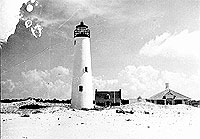 Cape St. George Lighthouse (photo taken 1950). Photo Credit: Florida Photographic Archives |
1835 - Apalachicola Land Company organized
The US Supreme Court ruled that the land in the Forbes Purchase was private. The now land-owning parties involved organized the Apalachicola Land Company in 1835. Because of the uncertainties surrounding land titles and taxes in the areas encompassing the Forbes Purchase, which included Apalachicola, many business investors looked to St. Joseph as a safer place to invest money and develop businesses. The lands encompassed by the Forbes Purchase, which spanned the Apalachicola River into Wakulla County, were said to be poor as they were not suitable for agriculture and they did not carry minerals. Over the next few decades, the Apalachicola Land Company had to give up much of its land to pay county taxes.
1836 - St. Joseph was incorporated.
Its citizens wanted St. Joseph to become the county seat of what was then Franklin County. However, by the summer of 1841, St. Joseph was deserted due to hurricanes in the late 1830's and the yellow fever epidemic in 1841.
1836 - The Apalachicola Land Company (ALC) dredge the Apalachicola Harbor.
The federal government also appropriated money in the 1830s to remove obstructions from the Apalachicola River and to deepen the channel in the bay and St. George Sound.
1830 - 1850
Episcopalians, Methodists, Baptists, and Catholics organized churches in Apalachicola from the 1830's through the late 1840's.
1840 - 1859
The citizens of Apalachicola suffered from repeated damaging hurricanes in 1842, 1844, 1850, 1851, and 1856. Also, the town battled major fires in 1842 and 1857.
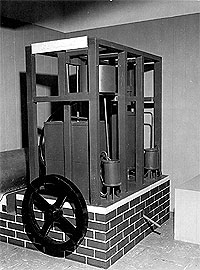 Model of first ice machine displayed at the John Gorrie Museum in Apalachicola. Photo Credit: Florida Photographic Archives |
Pre-Civil War Era
On the eve of the Civil War, Apalachicola was the sixth largest town in Florida with 1,906 residents. The city of Apalachicola grew rapidly because of its location at the mouth of the river. In 1860, the city's chamber of commerce declared that “we do more business than each and every portion of the State put together.”
But while Apalachicola received 80% of the cotton produced in its river drainage in 1850 it had declined to 43% by the end of the decade. In the South, the economy was expanding with competition from Columbus, from the railroad and new textile mills. The economy of Apalachicola and Franklin County was not diversified. For example, there were only 3 farmers in the 1860 census and there was no industrial economy at all. The fishing industry had great potential but there was no export market at the time, only local.
Civil War Era
Florida's Civil War Militia was established on February 14, 1861 and the Confederate Congress's army on March 6, 1861.
The Union had a blockade on in the St. George area. Despite the blockade some vessels did enter and leave without Union interception.
Governor Milton called Apalachicola the first line of defense for the interior of the state and wanted more Confederate troops/supplies in 1862 since state troops were to be dissolved by March 10, 1862. When the troops left, many of the town's population went into Georgia and Alabama.
Post-Civil War (1865 - 1870)
After the Civil War, Apalachicola was limited by few and inadequate roads, dwindling water transportation for commerce, and a total lack of railroads. Some attributed the difficulties to an unimproved port and a lack of consistent channel depth. But others believe a bigger problem was the completion of the Atlantic and Gulf Railroad to Bainbridge, Georgia. This railroad connected the heart of the Apalachicola - Flint - Chattahoochee River basin directly to Savannah, Georgia, diverting cotton that would have been bound for Apalachicola.
1870 - 1890
Beginning in 1873, hurricanes and freezing weather destroyed warehouses and local citrus trees around Apalachicola and the town began a gradual decline in prosperity.
A fire at the courthouse destroyed many of Franklin County's land records, including any source title for St. George Island.
With no farming or industrial economy, the lumbering industry was revived in 1870. One of the first was the Pennsylvania Tie Company, which made railroad ties from cypress logs.
Demand for timber revived the drive to make Apalachicola a deep-water port. Beginning in 1882, money was spent to deepen East Pass and develop a deeper and wider channel entrance from the bay into the Apalachicola city's wharves. A good harbor entrance from the Gulf still did not exist through West Pass.
James N. Coombs was one of the most important men in the lumber industry from the late 1870's until 1900. He was one of the area's wealthiest men.
St. Teresa is founded in 1875 on St. James Island by Dr. Phavious Byrd.
In the late 1870's, intensive efforts begin to harvest the oyster beds in Apalachicola Bay. Some prominent oystering companies were John C. Messina and Company, Yent and Alexander, John Miller, and Joseph Segras.
In 1880, Franklin County's population was 1,791 but still below the 1860 population of 1,904. There was no sewer or street lights and few people had wagons or buggies.
Horace H. Humphries buys one-third of St. George Island for $21. on August 1, 1881.
John G. Ruge and his brother establish the Ruge Brothers Canning Company in 1885. They became Florida's first successful commercial oyster packers by using pasteurization.
C.L. Storrs and R.F. Fowler operated a sawmill at the site of present-day Carrabelle. By 1890 the town was the center of a growing naval stores industry, with many turpentine stills located between their sawmill and Apalachicola.
1893 - Town of Carrabelle incorporated
The settlement of Carrabelle actually began in 1855. The mouth of the Carrabelle River had excellent fishing, so hunters and fishermen used the river's east bank for their outings. By 1855, a few decided to make their residency permanent. Oliver Kelley was the man chiefly responsible for Carrabelle's growth. Kelley moved to the area in the late 1870's and recognized its potential for a harbor. In 1877, Kelley bought 1,920 acres of land near there. His niece was Carrie Hall, and she was considered the “belle” of the local community, so Kelley named the new town Rio Carrabelle. Carrabelle became a center for lumber and the emerging seafood industry, reaching a population of 923 in 1900.
1895- The Crooked River lighthouse, originally authorized in 1889, is completed.
1895- Height of the sponge industry in Apalachicola
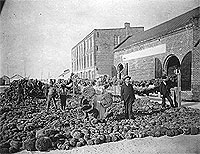 Apalachicola sponge exchange, ca. 1895. Photo Credit: Florida Photographic Archives |
1898- Eastpoint established as an experimental colony by the Brown family.
Eastpoint was founded by a group of families from Nebraska that set up a cooperative colony with all profits being shared. They were engaged in farming, seafood, lumber, and manufacturing.
1900- Fire destroys Apalachicola business district
On May 25, 1900, a fire broke out in a kitchen in Apalachicola. Spreading quickly, the fire burned 71 buildings, including almost all of the business section of Apalachicola. Many of these businesses could not rebuild. Some believe it was this fire that forced a change in the industry focus in Apalachicola from lumbering to oysters, shrimping, and associated seafood processing. Today, Franklin County's economy continues to be heavily dependent on those same industries, although second homes and vacation rentals are playing increasingly important roles in the Franklin County economy as well.
1900 - 1920
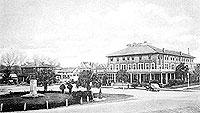 The Gibson Inn in Apalachicola (photo taken in 1940's). Photo Credit: Florida Photographic Archives |
1920 - 1940
By the 1920's, shrimpers had shifted their primary base of operation from Fernandina Beach to Apalachicola and Franklin County. The industry was founded by a Sicilian immigrant around 1900.
On Oct.1, 1920, William Popham established the Oyster Growers' Co-Operative Association, to plant, harvest, handle, and process oysters. He quickly sold 1000 shares in the business and tied the future of the association to acquiring St. George Island. By late summer of 1921 the association was capitalized at $425,000 and Popham bought SGI for $27,224.50 total.
Popham is elected mayor of Apalachicola in November of 1923.
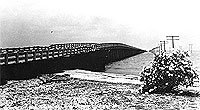 John Gorrie Bridge. Photo Credit: Florida Photographic Archives |
World War II
Apalachicola residents' response to the war was overwhelming. Franklin County was one of three counties in the US whose volunteer enlistments exceeded its quota in the first two drafts.
Originally named Camp Carabelle, Camp Gordon Johnston was established in Franklin County and was home to 30,000 military personnel, training an estimated 250,000 troops for D-Day. The camp stretched from Alligator Point to Carrabelle and included the villages and Lanark and St. Teresa, Dog Island, and St. George Island. It was the second largest military installation in Florida. By 1948, most of the buildings had been demolished and the lands transferred back to private ownership. The former officers' family quarters are in the Lanark Village Retirement Community.
In 1942, the US Government took control of St. George Island for the duration of the war, using it for gunnery practice and amphibious warfare.
Post World War II
The western third of St. George was called Little Saint George and was divided by a passage (New Inlet or West Gap) maintained by hurricanes. In 1957, the Army Corps made it permanent with Bob Sikes Cut, about 3 miles east of New Inlet.
By 1970, the St. George Island and Apalachicola area had become center of struggle between those wanting to preserve the area in its natural state (e.g., environmentalists, people associated with the seafood industry) and those wanting to have more human amenities in the area (e.g., developers, travel-related businesses such as restaurants and motels).
The new Bryant Patton (St. George Island) Bridge is built and opened on February 16, 2004. The bridge is the third longest in Florida and the longest in north Florida.
On October 21, 2005, the 153-year old lighthouse on Little St. George Island fell into the surf and broke apart.
Miscellaneous Historic Items of Interest
Between 1828 and 1861, 64 steamboats listed Apalachicola (AP) as their home port and over twice that number were active on the river system. Over 80% were side-wheelers because they were more powerful and had greater maneuverability.
The Trinity Episcopal Church at 6th Ave. and Ave. D was built in New York. It was cut into pieces sailed around the Florida Keys before being erected on its present site in 1836.
REFERENCES
Chapel, George L, n.d., Apalachicola Historical Society, Accessible on the WWW at: http://www.visitfranklincounty.com/bibliography.htm
Florida Historical Markers Program, Florida Division of Historical Resources, accessible on the WWW at: http://dhr.dos.state.fl.us/bhp/markers/markers.cfm?ID=Franklin
Rogers, William W., 1986. Outposts on the Gulf: Saint George Island and Apalachicola from Early Exploration to World War II. University Presses of Florida, Gainesville, FL 297 pp.
Note: The content of the website has not been updated since 2005. The site remains online for it's value as legacy content and is unlikely to be updated.